Cement
Failing the Test on Smog
 This is a response to statements in this.
This is a response to statements in this.
1) "The downward trend" that Mr Clawson of TCEQ says has only been "interrupted," is, in fact continuing, and he knows this because it's TCEQ monitoring that's proving it. This last March saw the highest ozone levels ever recorded for that month since TCEQ air quality monitoring began in 1997. It's only June, and there are already two monitors whose three-year runing average "Design Value" is above the old 85 ppb standard. The "best ever" ozone summer we were supposed to experience this year, according to TCEQ's prediction to EPA submitted in December, is completely off the rails.
2) The "87 ppb" Design Value Mr. Clawson cites is from 2010. Last year it was 92 ppb – at the Keller monitor. This year so far, the Keller monitor is already at a Design Value of 87, a violation of the old standard and something TCEQ said would not happen.
3) The NCTCOG claim that,"the DFW region has a tougher time than other metropolitan areas in the U.S. because of its climate plus its position downwind from outside sources of pollution" is also misleading. Houston is a hotspot for bad air, and yet last year DFW exceeded the number of bad air days and the severity of the violations in that city. Other metropolitan ares downwind of power plants as well as DFW, and yet they've all managed to do better in achieving cleaner air. Atlanta, Phoenix, and other Sunbelt cities that started out at the same smoggy spot a decade ago have all conquered the old 85 ppb std. DFW has not. It's already blown it again this year. Instead of blaming climate or coal plants, it is more realistic to blame DFW's air quality failure on a lack of political will by local and state officials to get serious about decreasing air pollution.
However, there is one large area of policy where the excuses of lack of will and new downwind sources collide – in the official lack of attention paid to the rise of Barnett and Haynesville Shale gas pollution as a source of smog in DFW.
4) The statement that only "5 percent" of the smog-forming emissions in DFW come from oil and gas drilling and production is also highly misleading. First, we know this is one of the fastest-growing categories of air pollution over the last decade. The increase in gas pollution is erasing decreases in emissions from other sources. Second, according to the information submitted by TCEQ to EPA last December, oil and gas emissions are the second largest source (20%) of smog-forming Volatile Organic Compounds, or VOCs in the 9-county DFW non-attainment area. That's more than the total VOCs produced by all on-road vehicles in the same 9 county area. Based on recent field studies by NOAA and others, this is probably an underestimate.
This statement also ignores the impact of gas emissions to the south and east of DFW, like Freestone County's, that are not included in the 9-county area inventory, but are probably influencing air pollution here.
What's always left out of this pie chart is the fact that cars now have a removal efficiency of approximately 90%. No other major sources come close to that kind of effort, despite technology being available to achieve it – at cement kilns, gas operations. and coal plants. That's where "the lowest hanging fruit" remains. But since all those industries are large contributors to the politicians directing the status quo, there's no political will to target them. Exhibit A: the 2011 DFW clean air plan submitted by the state, which relies primarily on marketplace forces to replace old cars with new ones, instead of any new round of pollution controls for any industry sources.
5) The NCTCOG claim that "monitors in the north Dallas and Frisco areas have had the highest readings of the region but the plume seems to be shifting west" is also based on old data. In fact, the opposite is occurring. Violating monitors are moving EAST (just like gas mining). And there are more of them. From 2008 to 2010, Eagle Mountain Lake and Keller were the epicenter of smog in DFW. But in 2011, while Keller tripped the std, EML did not. Moreover, during that same 08-10 period there were only 1-3 monitors in violation of that std. Last year, there were seven. And they included not just Keller and Parker County, but Denton, Grapevine, Pilot Point, Frisco and North Dallas – directly in contradiction to the NCTCOG claim.
This year, the very first monitor to record four "exceedances" of the 85ppb std was located near Mockingbird and I-35 in Central Dallas – the first time that monitor has done so since 2005. Moreover, the fourth exceedance came in June – the earliest that has happened since 2006, when 12 out of 19 monitors were in violation at the end of the summer.
As much as the officials and agencies would like us all to ignore the summer of 2011 and think of it as an aberation, it would be more prudent to see it as another warning sign that DFW needs to do much more to get safe and legal air.
Wastes Waiting to Be Burned in Kiln Ignite Unauthorized Fire
What local news reports called a "massive fire" swept through the piles of industrial wastes waiting to be burned at the Argos Cement Plant in Harleyville South Carolina yesterday. Ten workers escaped injury, but the fire was so intense that it required the assistance of outside fire departments totaling 75 firefighters, three trucks and two aircraft, and lasted all day as crews snuffed out hot spots.
Starting at about 5 in the morning, the fire quickly engulfed the 60 by 100 foot warehouse stuffed with carpet pieces, paper, and rubber ready to be put into the cement kiln as "fuel." Imagine a landfill or tire fire and that's the kind of heat, smoke and toxicity you've got to deal with when your "recycled fuel" goes up in flames.
Of course, health officials denied there was any risk of exposure to toxic fumes even as they were still trying to determine exactly what was in the warehouse. That's the deductive reasoning process in action when it comes to local officials in company towns. Harleyville is home to the second-largest concentration of cement manufacturing in the country, behind only Midlothian. It hosts two large plants – Argos and Giant. It's also been a center of kiln waste-burning since the 1980's
The kinds of wastes that caught fire in South Carolina are among those that TXI now has a permit to burn in its Midlothian cement plant, along with car interiors and plastic garbage. A permit that did not offer any public comment or hearing opportunity. The Ash Grove and Holcim Midlothian cement plants also burn industrial wastes including tires and used oil. In the mid-1990's a tire "recycling" firm in Midlothian connected to the cement plants caught fire and burned for days with the black smoke wafting through downtown Dallas skyscrapers.
Halfway to Failure
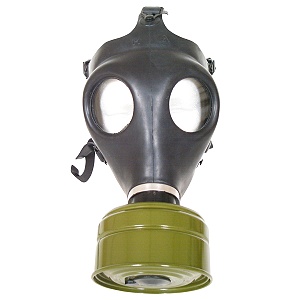 (Late Monday evening update: It's clear that the Hinton Street monitor will record its third "exceedence" of the 85 ppb standard this year, putting it just one away from making the entire region non-attainment" in 2012.)
(Late Monday evening update: It's clear that the Hinton Street monitor will record its third "exceedence" of the 85 ppb standard this year, putting it just one away from making the entire region non-attainment" in 2012.)
It's a bad sign when there are ozone problems on the weekends. It means that even with less people on the road and many businesses on less than full throttle, there's still enough pollution to cause trouble. And it usually means a rough week ahead. That's what happened on Sunday, when summer finally caught up with DFW in a big way.
Four area ozone monitors set new annual highs set on Sunday, and many others saw very alarming numbers during the afternoon. There were three "exceedences" of the old 1997 85 parts per billion ozone standard, and one of those was the second time the Dallas Hinton Street site had seen an 8-hour average above 85 this year. Six other monitors have already had their first. And it's only June.
Four such exceedences within a year puts a monitor in official violation of the obsolete standard that DFW is still struggling to meet. So with the Hinton Street results, we're already halfway to being out of compliance with the 1997 standard again. But it's all academic. Everything is now geared toward meeting the new 75 parts per billion ozone standard by 2018. DFW could be in violation of the old standard every year from now until then, and except for the terrible toll on public health, there'd be no penalty from either the EPA or TCEQ.
On the other hand, its going to be pretty hard to meet that new, harder standard when you haven't been meeting the old, easier one.
The state's official response is mostly to sit back and hope that DFW drivers trade in their older, more polluting cars for cleaner, newer ones. That phenomena was supposed to be responsible for making this year the best one for clean air in decades. According to the Texas Commission on Environmental Quality's computer modeling, no DFW monitor will violate the Clean Air Act for ozone pollution in 2012. At least, that's what they told the EPA when they submitted the region's clean air plan to the feds in December. And the EPA bought it. Because the TCEQ computer modeling said everything was hunky-dory.
But reality has a way of rudely intruding on TCEQ's computer modeling. Only six months into the new plan and most of the DFW monitor averages predicted by the state are already underestimates. We had the highest ozone levels ever recorded in March. Maybe there's just not enough of you trading in your cars.
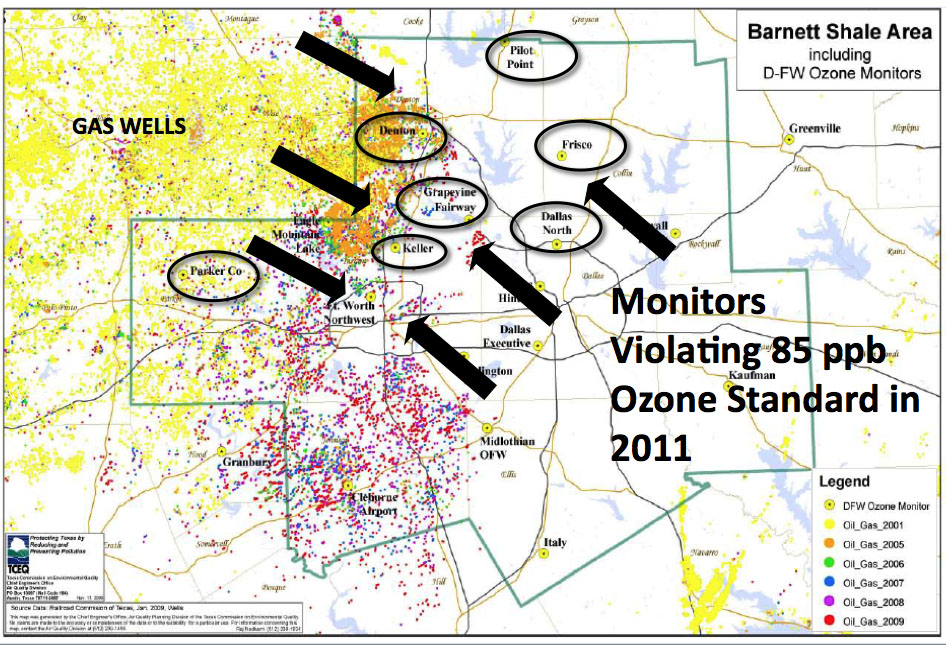 Or maybe it's just that old TCEQ junk science at work. One thing we know the state's computer model didn't consider was how already-dirty air makes the VOC pollution from natural gas operations more easily convert into ozone pollution. Denver officials who are also dealing with new gas operations contributing to long-standing smog problems have considered this factor and think it explains larger than expected ozone readings there.
Or maybe it's just that old TCEQ junk science at work. One thing we know the state's computer model didn't consider was how already-dirty air makes the VOC pollution from natural gas operations more easily convert into ozone pollution. Denver officials who are also dealing with new gas operations contributing to long-standing smog problems have considered this factor and think it explains larger than expected ozone readings there.
TCEQ chose to ignore this variable. Supposedly because the gas patch was well west of DFW and "couldn't possibly" affect North Texas ozone levels. But as anyone who's driven I-30 or I-20 over the past ten years can tell you, the gas patch extends all the way from east of Denton to Grand Prairie to Midlothian, encompassing most of the 9 county non-attainment area. In the same December 2011 clean air plan the state predicted record-low ozone levels this year, it also estimated that gas industry sources were emitting 34 tons per day more smog-forming VOC pollution than all the cars and trucks in DFW combined.
It was a political decision not to look at how dirty air from Houston, the East Texas coal plants, the Midlothian cement kilns and everything else east of Weatherford makes gas industry emissions more likely to cause ozone in North Texas. TCEQ's clean air plans are always full of such decisions that drive the final results of its supposedly objective computer modeling. Hard to believe now, but there was a time in the not-so-distant-past that the same computer modeling made it clear that the Midlothian cement plans "couldn't possibly" be affecting DFW ozone levels.
A plan to meet the new 75 ppb standard must be submitted to EPA by 2015 to show three years of compliance by 2018. That's only two-years away. If new cars alone can't get us down below 85, it will be extremely difficult for the state to argue they can get us down to 75. More actual things that work to reduce pollution will be necessary. Including bringing better controls to the cement kilns and coal plants and other industries still putting out way too much pollution. It will be a fight. but so far, the evidence is that more is needed if DFW is ever going to have safe and legal air.
Clean Air As Political Football
 Yesterday's Senate vote on rolling back the new EPA Mercury rules for power plants is a great example of how both sides use fake controversies to puff-up their political bone fides and financial support.
Yesterday's Senate vote on rolling back the new EPA Mercury rules for power plants is a great example of how both sides use fake controversies to puff-up their political bone fides and financial support.
At issue is another move by Senator Inhofe of Oklahoma to gut the widely popular regulations that would establish limits for mercury pollution from power plants – the largest source of the air-borne poison in the US.
Inhofe's motives are pretty clear – this is just one more run at trying to deconstruct the EPA and the last 40 years of government-mandated clean air provisions. This is what the Senator does. Even when he knows he doesn't have the votes to win weeks in advance, as was the case with this vote. Why? Because it's a presidential election year and the EPA is red-meat to the Republican Party core constituency. After a week of publicity about the rules and the chance to demagogue against them, the vote itself is a mere formality. In fact, losing the vote gives the Senator a chance to say that the only way to permanently get rid of these kinds of awful business-killing EPA regulations is to elect a Republican president and Senate. Get those fundraising letters out. Mission accomplished.
Likewise, many of you probably received urgent appeals from large national environmental groups to e-mail your Senators about this power plant vote or risk losing the rules. This too was political posturing. If you'd been keeping track of the debate, you knew Senator Inhofe did not have the votes to win in the Senate. And even if he had somehow won, the President still would have vetoed the bill. The rules themselves were never in any danger. So why send out urgent appeals? Because it's a presidential election year and the Republican threat to EPA is a red meat issue to a core Democratic/Environmental constituency. After a week of scaring people into believing the rules were in jeopardy, the vote itself was a mere formality. And the "closeness" of the vote means that the only way we can protect rules like these is to keep a Democratic president and Senate. Cue those fundraising appeals. Mission accomplished.
Tomorrow, it's very likely that the Obama Administration will begin the self-inflicted process of dismantling parts of the EPA's new emission rules for cement plants that Downwinders and others have worked almost two decades to see implemented. These rules govern Mercury emissions too – cement plants are also a major source. For no reason that anyone in the environmental establishment in DC can understand, the EPA is going out of its way to weaken and delay these rules. This is not a drill. This is actually happening. And it's not the fault of Senator Inhofe this time. It's the Obama EPA. But the Senator won't be crowing about it because it doesn't conform to his own popular narrative about an anti-business EPA. We'll wait and see, but we also imagine there won't be any urgent national calls from Washington environmental groups next week to stop the EPA from eating its own and save the cement plant rules. That's not the narrative they're trying to sell either.
But it's the one taking place on the ground in Midlothian and another two dozen or so communities across the country that were depending on these rules to make their lives less miserable.
ATSDR E-Mail Address For Comments is Bad, Compensates with Week Extension
 The ATSDR finally admitted that, yep, that e-mail address we published for people to submit their commnets on the Agency's Midlothian "health consultation" doesn't work and never will work, and so they're providing another and extending the commenting opportunity by one week to Friday, June 29th. Here's he entirety of the ATSDR's response:
The ATSDR finally admitted that, yep, that e-mail address we published for people to submit their commnets on the Agency's Midlothian "health consultation" doesn't work and never will work, and so they're providing another and extending the commenting opportunity by one week to Friday, June 29th. Here's he entirety of the ATSDR's response:
ATLANTA— The public comment period for the recently released Midlothian Public Health Assessment has been extended to June 29, 2012.
Comments on the document must be made in writing and those received during the public comment period will appear in the final version of the health consultation. Comments (without the names of persons who submitted them) and ATSDR’s responses to these comments will appear in an appendix to the final health consultation. Names of those who submit comments will be subject to release in answer to requests made under the U.S. Freedom of Information Act (FOIA).
Send comments to: rlm6@cdc.gov,or mail to:
ATSDR Records Center
Attn: Rolanda Morrison
Re: Midlothian Area Air Quality – PHC #1
4770 Buford Highway, NE (MS F-09)
Atlanta, Georgia 30341
No "We're sorry we screwed-up the public comment process" or "It's all our fault, try again." We could say this is one big metaphor for the Agency's multi-year invovlvement in Midlothian, but we won't. We'll let you do that in your comments.
PM Follow-Up: the 2005 Spike and the Midlothian Drop
 (Note: Downwinders sent out an air quality alert on Monday urging folks to send their comments 1) into EPA to support the new PM standard, and 2) the federal ATSDR in regards to its "health consultation" in Midlothian. The correct address for the PM comments is "a-and-r@docket.epa.gov" – the same as the alert, but apparently the the whole address didn't get underlined. Use the complete address and you shouldn't have any problem. The ATSDR address for comments used in the alert is cut and pasted from the agency's own website, but was rejecting comments Monday afternoon for some reason. Complaints have been made and we hope they'll actually be allowing comments on Tuesday.)
(Note: Downwinders sent out an air quality alert on Monday urging folks to send their comments 1) into EPA to support the new PM standard, and 2) the federal ATSDR in regards to its "health consultation" in Midlothian. The correct address for the PM comments is "a-and-r@docket.epa.gov" – the same as the alert, but apparently the the whole address didn't get underlined. Use the complete address and you shouldn't have any problem. The ATSDR address for comments used in the alert is cut and pasted from the agency's own website, but was rejecting comments Monday afternoon for some reason. Complaints have been made and we hope they'll actually be allowing comments on Tuesday.)
In covering the PM 2.5 standard announcement, a lot of attention was paid by the media to the fact that only a handful of counties in the US would not be able to meet the new number by 2020. The Obama Administration worked hard to send that message in order to preempt the kind of backlash that killed last year's new smog standards. But what are the actual levels now and how close or far is DFW from ever having to worry about being in non-attainment for PM pollution?
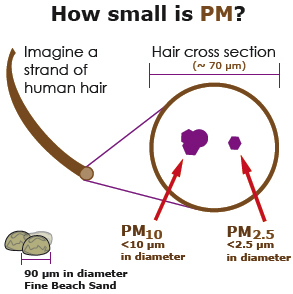 The new standard is an annual average of 13 micrograms per cubic meter of air, expressed as ug/m3. As far as we can tell from the monitoring records TCEQ keeps online, DFW hasn't come close to exceeding that number. But that's not really as conclusive as it might first sound. There are only two PM 2.5 monitors located in the heart of the DFW metropolitan area. One is on /Hinton Street near Mockingbird and Harry Hines in Dallas and the other is at the Haws Athletic Center location just north of downtown Ft. Worth. All others are in far southern Ellis County, Kaufman County, or Johnson County and act as "background" monitors to track PM pollution coming in or leaving urban DFW. In contrast, there are at least nine ozone monitors located in urban/Suburban DFW .
The new standard is an annual average of 13 micrograms per cubic meter of air, expressed as ug/m3. As far as we can tell from the monitoring records TCEQ keeps online, DFW hasn't come close to exceeding that number. But that's not really as conclusive as it might first sound. There are only two PM 2.5 monitors located in the heart of the DFW metropolitan area. One is on /Hinton Street near Mockingbird and Harry Hines in Dallas and the other is at the Haws Athletic Center location just north of downtown Ft. Worth. All others are in far southern Ellis County, Kaufman County, or Johnson County and act as "background" monitors to track PM pollution coming in or leaving urban DFW. In contrast, there are at least nine ozone monitors located in urban/Suburban DFW .
Tracking the two central city core monitors over the last ten years shows a slow but steady rise in the average PM 2.5 levels being recorded, staring at a little below 9 ug/m3 in 2002 and ending with an 11.01 last year. That's an increase of almost 2 ug/m3 in a decade. 2011 was a drought year and so there was probably more dust in the air. But records show other years where annual averages were in the high-10 to 11 ug/m3 range. What they also show is that these higher levels all come after 2005. In fact, across the board, at all the DFW monitors recording PM levels from 2004 to 2005, there was a statistically significant jump from annual averages in the high 8 ug/m3 range in 2004 to over 11 ug/m3 by the end of 2005. And while some monitors came back down, the two central city monitors have stayed up – particularly at the Ft. Worth site. So what happened in 2005? There was a Mexican volcano eruption that summer, but it ended. The higher PM averages in North Texas didn't. It was too soon to see the effects of urban drilling, although that may play a part in keeping the Ft. Worth levels higher now. Whatever it was, it makes a clear bright line that separates the pre-2005 lower numbers from the post-2005 higher ones.
Last year's average of 11.58 ug/m3 at the Dallas site was the highest at that monitor, or any other, in the last ten years. It's less than 1.5 ug/m3 away from breaking the brand new PM standard of 13. That same monitor has already seen a 2.25 ug/m3 increase in annual averages since 2002.
EPA says don't worry, but we'd keep our eyes on those long term trends.
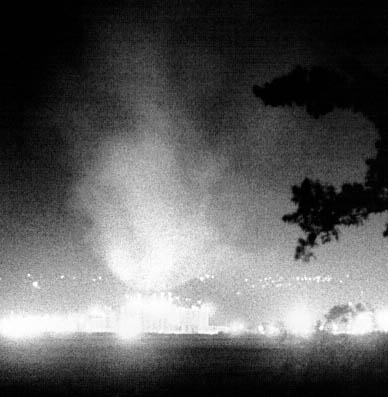 The Obama administration is banking on the impact of new power plant rules, cement plant standards, and other emission-affecting regulations to lower PM levels over the next eight years. And that could be a good bet. One of the things that also sticks out from the limited amount of DFW PM data is how much of a drop there's been at the Midlothian monitor located north of the TXI cement plant over the last five years after reaching a peak in 2008. That was the year TXI decided to shut down its four obsolete wet kilns that burned hazardous wastes and rely solely on its newer and generally less polluting dry kiln. In 2008, the Midlothian monitor recorded an annual level of 10.7 ug/m3. Last year it recorded an annual average of 8.0. That's progress.
The Obama administration is banking on the impact of new power plant rules, cement plant standards, and other emission-affecting regulations to lower PM levels over the next eight years. And that could be a good bet. One of the things that also sticks out from the limited amount of DFW PM data is how much of a drop there's been at the Midlothian monitor located north of the TXI cement plant over the last five years after reaching a peak in 2008. That was the year TXI decided to shut down its four obsolete wet kilns that burned hazardous wastes and rely solely on its newer and generally less polluting dry kiln. In 2008, the Midlothian monitor recorded an annual level of 10.7 ug/m3. Last year it recorded an annual average of 8.0. That's progress.
Downwinders, The Early Years
Looks Like EPA Will Stymie Hard-Won Cement Plant Rules On Friday
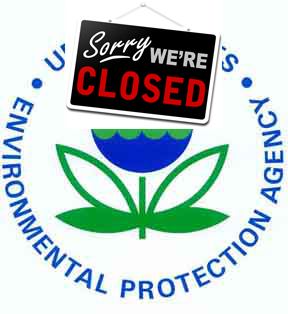 We don't this very often, but because many of you spent so much time helping us get the first new cement plant emissions rules in 20 years, we thought it was important to reprint the entirety of a Subscription-Only INSIDE EPA article from Tuesday that puts the fate of those rules very much in question:
We don't this very often, but because many of you spent so much time helping us get the first new cement plant emissions rules in 20 years, we thought it was important to reprint the entirety of a Subscription-Only INSIDE EPA article from Tuesday that puts the fate of those rules very much in question:
Activists Warn Possible EPA Weakening Of Cement MACT Likely Unlawful
New Cement Plant Rules in Trouble at EPA?
 There's been a flurry of news about cement plant pollution this past week or so that we haven't been able to cover as well as we should have for a clean air group that has the largest concentration of cement manufacturing capacity in the US in its own backyard. Most important of all is the possibility that EPA will mess with its tough new cement plant emissions rules that Downwinders and so many of you fought long and hard to get passed. These are the rules that were at the center of the 2008 DFW airport hearing that drew 200 people – the largest hearing on them in the country. These are the rules that are forcing old wet kilns like Ash Grove and others around the country to finally modernize. Originally mandated to come on line in 1997, they're just now on the verge of being promulgated as final by EPA. Only there's a catch. For no apparent reason that anyone in the environmental side of the table can figure out, EPA is seriously considering giving industry a two-year extension that no court has ordered EPA to give them. There's a June 15th deadline that the agency imposed on itself, to respond to a Portland Cement Association's petition to either delay the rule outright until 2015 instead of 2013, or take comment on such an extension. Either move would delay the implementation since they're on schedule to become official in November. No one at EPA will say why they're taking the PCA petition so seriously when they've spend the last two decades blowing off similar requests by citizens. Downwinders, along with 14 other local groups, has signed a letter going to EPA Assistant Administrator Gina McCarthy that protests ANY delay and asking her to reject the PCApetition. Downwinders Director Jim Schermbeck was one of seven people that met with McCarthy in Washington DC earlier in the month to discuss how important these rules are to places like Midlothian – where's there not one, not two, but three cement plants operating within close proximity to one another. While the meeting went well, McCarthy was non-committal. We're not ones to quietly sit on the sidelines as something that we've worked for almost 20 years gets victimized by what looks to be election year politics. Expect to see more in the coming days about what you can do to prevent this public health tragedy from an increasingly wimpy EPA. Stay tuned
There's been a flurry of news about cement plant pollution this past week or so that we haven't been able to cover as well as we should have for a clean air group that has the largest concentration of cement manufacturing capacity in the US in its own backyard. Most important of all is the possibility that EPA will mess with its tough new cement plant emissions rules that Downwinders and so many of you fought long and hard to get passed. These are the rules that were at the center of the 2008 DFW airport hearing that drew 200 people – the largest hearing on them in the country. These are the rules that are forcing old wet kilns like Ash Grove and others around the country to finally modernize. Originally mandated to come on line in 1997, they're just now on the verge of being promulgated as final by EPA. Only there's a catch. For no apparent reason that anyone in the environmental side of the table can figure out, EPA is seriously considering giving industry a two-year extension that no court has ordered EPA to give them. There's a June 15th deadline that the agency imposed on itself, to respond to a Portland Cement Association's petition to either delay the rule outright until 2015 instead of 2013, or take comment on such an extension. Either move would delay the implementation since they're on schedule to become official in November. No one at EPA will say why they're taking the PCA petition so seriously when they've spend the last two decades blowing off similar requests by citizens. Downwinders, along with 14 other local groups, has signed a letter going to EPA Assistant Administrator Gina McCarthy that protests ANY delay and asking her to reject the PCApetition. Downwinders Director Jim Schermbeck was one of seven people that met with McCarthy in Washington DC earlier in the month to discuss how important these rules are to places like Midlothian – where's there not one, not two, but three cement plants operating within close proximity to one another. While the meeting went well, McCarthy was non-committal. We're not ones to quietly sit on the sidelines as something that we've worked for almost 20 years gets victimized by what looks to be election year politics. Expect to see more in the coming days about what you can do to prevent this public health tragedy from an increasingly wimpy EPA. Stay tuned
They Were Against Clean Air Before they Were For It
 It's always a good darkly-comic read when fierce opponents of clean air take credit for progress even while they're still fighting against it. So get ready from some really twisted pretzel logic as you tackle the official and severely anti-climatic Ash Grove press release that announces the 2-year, $136 million effort to convert the Last Wet Kilns in Texas™ to dry kiln technology, eliminating hundreds of thousands of tons of air pollution by 2014.
It's always a good darkly-comic read when fierce opponents of clean air take credit for progress even while they're still fighting against it. So get ready from some really twisted pretzel logic as you tackle the official and severely anti-climatic Ash Grove press release that announces the 2-year, $136 million effort to convert the Last Wet Kilns in Texas™ to dry kiln technology, eliminating hundreds of thousands of tons of air pollution by 2014.
This news was first broken by us last January, then Ash Grove applied for the state permit it needed (w/o having to be bothered with public notice or comment), and then again over a week ago when we pointed out they'd ink the engineering contract. Nevertheless, we'll leave it up to the company to have the belated last word. But you're not going to find any mention of Downwinders' seven-year "Green Cement Campaign," or the more than a dozen local governments that overwhelmingly voted for procurement policies that explicitly said they were not buying wet kiln cement because it produced too much air pollution. Or the lawsuit that Ash Grove eventually was forced to file when they lost a 5-0 vote over such a procurement policy at the Tarrant County Commissioners Court. Or how Downwinders successfully intervened last year to protect those procurement policies when Dallas and Arlington were thinking about ditching them over that Ash Grove lawsuit. No, Charles Sunderland the Third and Company would rather drink lye than give us our due.
But the press release does cite the "U.S. Environmental Protection Agency’s (EPA) portland cement National Emissions Standards for Hazardous Air Pollutants (NESHAP) rule, which are scheduled to take effect in Sept. 2013," as a determining factor in the modernization.
That would be the same standard that over 200 local residents supported in-person throughout a day-long hearing at DFW airport in 2008. It was the largest, best-attended hearing on the rules that EPA hosted that year, including stops in L.A. and Washington D.C. , capping over a decade of organized support from Downwinders at Risk. No other single grassroots group did more for so long to make sure those rules got approved because no other group was faced with such a concentration of old, dirty wet kilns that we knew would have to modernize to conform to them. By linking their decision to the NESHAP standard, the company is at least acknowledging a large factor that Downwinders had a large impact on. But the comedy of the Ash Grove press release lies not in what it leaves out, but what it crams in – toasts to its success from all the elected officials who worked do diligently to destroy the NESHAP rule and, or thwart our Green Cement Campaign.
“My colleagues will be delighted, as I am, to know that Ash Grove is making this investment in Midlothian during difficult economic times. The costs that this company is incurring to comply with mandated federal air emissions regulations are incredible while sales are down in the industry by more than 40 percent. We are fortunate that they are 0making this investment in Texas. In my estimation, Ash Grove always has been a leading corporate citizen,' Texas House Appropriations Chairman Jim Pitts (R-Waxahachie) said in his reaction to the decision."
Give him points for consistency: Rep. Pitts was against the federal cement plant rules when the economy was booming too. And he fought any and all attempts to protect the downwind cities from Ash Grove's green cement lawsuit in the Texas legislature. But he's delighted that both evil strategies worked in concert with one another and produced this wonderful result!.
Smokey Joe is merely pleased: “For years, I’ve seen these companies scrutinized by groups who would rather shut them down and force Texans to rely on imported cement. In spite of that, in a bad economy, Ash Grove has chosen to continue to operate in Texas and further improve on its record of reducing air emissions. I am pleased by Ash Grove’s decision and by the knowledge that it will be among the lowest emitting cement producers in Texas,' said U.S. Rep. Joe Barton (R 6)….."
Yes. That's the same Joe Barton still trying to sabotage the very NESHAP rules he's congratulating Ash Grove for following. Don't spend too much time thinking about the hypocrisy in this one, it'll make you pass out. In point of fact, the fight over cement pant pollution in Midlothian has been about citizens dragging an industry kicking and screaming into the 21st Century, being forced to reduce its pollution but also becoming more efficient. Jim Pitts, Smokey Joe, and Charles Sunderland the Third never mention that while pollution has been significantly reduced in Midlothian as a result of all those nasty federal mandates and citizen lawsuits and permit fights, the actual manufacturing capacity to make cement at Midlothian's three cement plants has grown.
